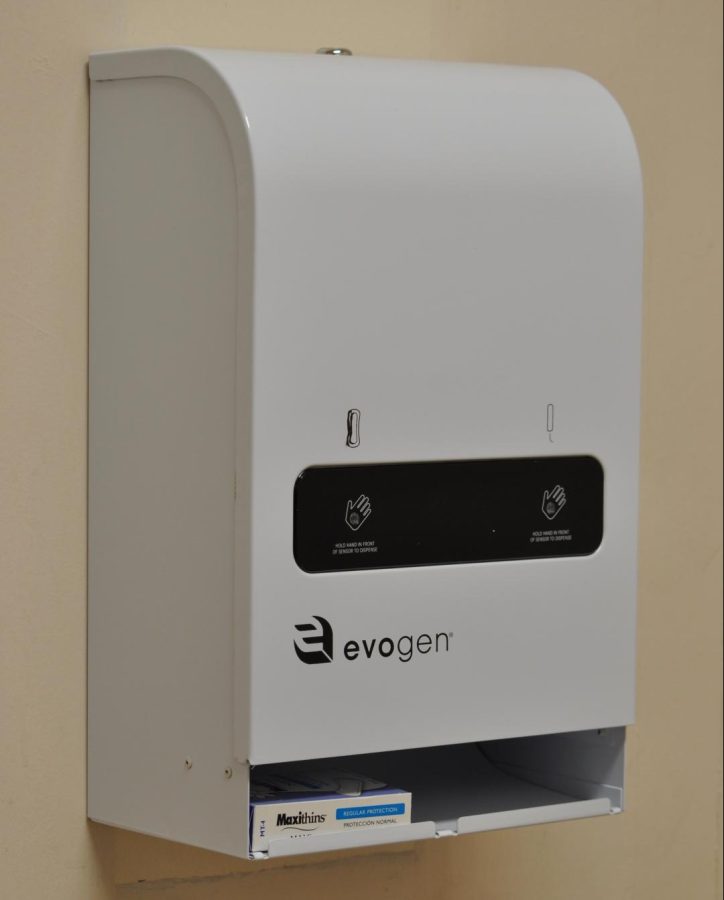Social Addendum: Dispensing facts about the need for accessible periods products in all OSU restrooms
A free tampon and pad dispenser can be seen in s single user restroom on the first floor of Waldo on Jan. 14. OSU is starting to install free tampon and pad dispensers across campus due to the Oregon Menstrual Dignity Act.
March 8, 2022
 Editor’s Note: This column does not represent the opinion of The Daily Barometer. This column reflects the personal opinions of the writer.
Editor’s Note: This column does not represent the opinion of The Daily Barometer. This column reflects the personal opinions of the writer.
The new period product dispensers on Oregon State University’s Corvallis, Ore. campus are an exciting step toward accessibility for everyone who menstruates, but OSU needs to ensure it actually happens.
These dispensers are being installed in accordance with the 2021 Oregon Menstrual Dignity Act, HB 3294, which now requires the presence of menstrual product dispensers in every student bathroom by July 2022.
The new dispensers will provide period products for free and will replace the old ones, regardless of if they were already free or working.
As a woman, I have long known that my chances of access to sanitary products are slim to none. The presence of dispensers does not guarantee the presence of accessible products.
It is also notable that the bathrooms that have tampons or pads in them are constantly changing. When I visited some of the different bathrooms on campus, within a day or two, I found the restrooms that previously had empty dispensers now had at least one pad or tampon. At the same time, dispensers are constantly being emptied as well.
In other words, even within one bathroom that has a free and functioning dispenser, you can never anticipate if there will or will not be a product there for you to use.
Joseph Majeski, OSU director of facilities, said they are still learning how much demand there will be for these period products. Majeski also said there is an extremely limited supply of period products that can fit in the dispenser and not jam it.
“Our goal is to not let [the dispensers] run out,” Majeski said.
Washington and California have also passed similar menstrual product bills, which is putting further strain on the supply of both products and dispensers.
Since dispensers are limited in supply, Majeski said OSU is preparing as much as possible for the dispensers such as pre-drilling the mounts. Dispensers will first be installed in one set of bathrooms in each building and then, as more become available, every bathroom will have one.
Menstrual products are just as necessary for sanitation as soap and toilet paper. Imagine needing to use the restroom and knowing only some people would have something to wipe with. Except the metaphor only works partially because you might be able to hold it in a little longer—assuming it is not already too late—but periods can not wait.
The law is aimed toward accessibility specifically for students. As it is written, only student bathrooms—bathrooms that are in areas associated with learning—are required to have the dispensers.
OSU is full of bathrooms in grey areas, though. The Kerr Administration building, for instance, is not technically a learning area, but it is a critical building for OSU students and still staffed with people who menstruate.
The lack of access to menstrual products is also a hindrance to learning and education.
“Students miss class time because of lack of access… They miss testing time and it just really profoundly impacts the students’ education and whether they feel like they can engage and connect in class,” said Sasha Grenier, sexuality education and school health specialist at the Oregon Department of Education.
According to Grenier, there have also been studies showing some ways in which students are affected by their lack of access.
“The organization Thinx found that one in five students have struggled to afford menstrual products and more than four out of five students, or the vast majority of students, have missed class time or know someone who has a lack of access to menstrual products,” Grenier said.
Grenier also cited a study of a school system in New York that, after providing free menstrual products in their bathrooms, had a 2.5% increase in attendance.
Period products are important to providing education, but it is also incredibly important to educate everyone about menstruation.
The Oregon Department of Education has a Menstrual Dignity Tool Kit to provide students and educators with guidelines to the Menstrual Dignity Act, which emphasizes privacy, inclusivity, accessibility and education.
OSU still needs to make good on its aim toward accessibility of period products. The presence of dispensers does not guarantee the presence of products, but the installation of dispensers in every bathroom is still a step in the right direction.
Oregon, along with Washington and California, are also setting good examples to improve not just quality of education, but also basic sanitation.
Hopefully, this is also a step towards menstrual products being standard in all bathrooms, just as soap and toilet paper are.
Periods happen. Period. You can’t stop the flow so our attitudes and education should reflect it.











































































































